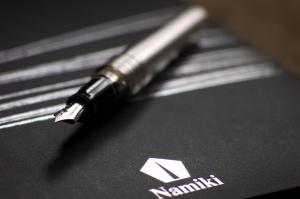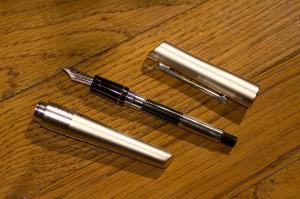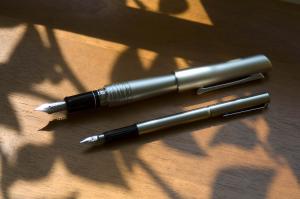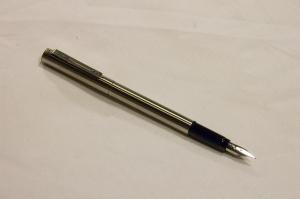
Pilots Great and Small
 In case there is any confusion, Namiki and Pilot are brands of the same company. Generally speaking, Namiki makes «fine» pens while Pilot sells office supplies. But the markets in different countries cause the company to shift those lines around. The Namiki Bamboo one might buy in the United States is available in Europe as the Pilot Bamboo. Similarly, I’ve seen the excellent Pilot Knight advertised as the Namiki Knight.
In case there is any confusion, Namiki and Pilot are brands of the same company. Generally speaking, Namiki makes «fine» pens while Pilot sells office supplies. But the markets in different countries cause the company to shift those lines around. The Namiki Bamboo one might buy in the United States is available in Europe as the Pilot Bamboo. Similarly, I’ve seen the excellent Pilot Knight advertised as the Namiki Knight.
Pilot/Namiki makes some fantastic pens. A company that does as good a job creating a three dollar pen as Pilot did with the Varsity (also known as the V‑Pen) is likely to do good things with its higher-end pens as well. Namiki’s pens range into the five-digit price tags with their handcrafted and meticulously painted Maki‑e pens. Unfortunately, the fountain pen market in the United States is anemic compared to our European and Japanese neighbors — a fact that’s sad considering that we once led the market. Today it’s difficult to get a good variety of pens from Japanese manufacturers like Pilot. Though Pilot sells many disposable pens in the USA, only a fraction of their fountain pen line is available here. A quick visit to http://www.pilotpen.us/ shows the only fountain pen they bother to show on their website is the disposable Varsity. The Knight and Vanishing Point can only be seen on the http://www.namiki.com/ website.
Please forgive me for teasing my American readers with pens we can’t easily get our hands on. These are two of my favorite modern writers, with writing characteristics as similar to one another as the pens themselves are dissimilar.
First let me introduce the pen that is not surprising. With a price tag that can reach almost five hundred dollars (the black resin model a full two hundred dollars less than the rhodium model in my photos) the Namiki Bamboo had better be a damn good pen. Moreover, the Namiki has to prove itself against its less-expensive siblings. At more than ten times the price of the already excellent Pilot Knight, can the Bamboo distinguish itself enough to justify the pricetag?
Of course, this question depends largely on the wants and needs of the individual, but the answer, conditionally, is yes. The Bamboo, especially in rhodium, is a weighty pen. The cap itself comes in at 21 grams, more by itself than many pens, cap and all. While many do prefer a heavier pen, this will be too much for some. Let me note here that the black resin model of the Bamboo is much less heavy, although it still is quite a substantial pen. I don’t have one to weigh, but nibs.com has a chart that brings it in at just over 33 grams, almost 20 grams less than the rhodium model.
The grip of the pen is a little odd as well. Some have reported it to be impossible to hold comfortably. There is a substantial difference in diameter between the barrel and the section, which can put your fingers in the awkward position of trying to grab on to a step. I could see this from the first time I held the Bamboo, but it’s a simple enough thing to adjust my grip so that my index finger is on the section and my thumb touches the barrel. It’s not at all uncomfortable and actually improves the comfort of my writing, as it forces me to let the pen rest snugly in my hand rather than attempt to hold on to it in a vise-like grip. I find that I hold the rest of my pens in this fashion, with the index finger forward. So does the Bamboo lose points for making me change my style to accommodate it or gain points for teaching me a better way to hold my pens?
The shape of the Bamboo is gorgeous. French designer Juliette Bonnamour, whose original design for the Bamboo included an inlaid nib rather than the traditional one supplied by Namiki, took inspiration from the bamboo plant without forcing the shape. The connection between the shapes of the pen and the plant it is named for is understated, yet plainly obvious. Namiki’s #10 nib creates an interesting contrast of shape and line, while Bonnamour’s original design of a smooth taper to a point, while clever, seems simply incongruous. This is not to criticize the designer for an earlier iteration; the point of revisions is to improve the piece, which she did quite successfully.
The rhodium model has a satiny finish that picks up the color of the light around it. It’s easy to see why (aside from being harder and more durable than other precious metals) rhodium is almost ten times as expensive as gold. The look of the Bamboo is impressive and alluring, and unique without being in any way awkward. This is no Montblanc knock-off or wannabe. The Bamboo’s shape could be the new classic.
Although I am impressed with precious metals, a beautiful pen that does not write well is not good for much besides collecting dust. I didn’t think there would be much chance of that; Namiki could have done as good a job with the Bamboo as it did with the Knight and justified the price on materials and design alone. The Bamboo, however, reaches for a higher level of quality. The production tolerances must be very close to zero, as each part fits very precisely with the next. Unscrew the cap and replace it, and the clip winds up in exactly the same orientation to the body, snug tight with so little effort I’d swear the cap was held in place magnetically. Everything about the pen is smooth and clean, and its writing is no exception.
 The Bamboo’s provided piston-style converter holds a generous amount of ink. This is a converter, so it will not hold as much as your favorite piston- or eyedropper-filler, but as converters go, this one is a tank. The piston’s operation is, like everything else about the Bamboo, mechanically precise and fluid. If all converters were like this, there would be fewer people looking down their noses at converter-filler pens.
The Bamboo’s provided piston-style converter holds a generous amount of ink. This is a converter, so it will not hold as much as your favorite piston- or eyedropper-filler, but as converters go, this one is a tank. The piston’s operation is, like everything else about the Bamboo, mechanically precise and fluid. If all converters were like this, there would be fewer people looking down their noses at converter-filler pens.
Japanese nibs run a half size to a full size smaller than European and American nibs. A fine point nib on a Japanese pen, therefore, will be closer to what many will expect from an extra-fine (EF or XF) nib. Indeed, this F Bamboo lays down a line very nearly the same breadth as my EF Rotring 600. Like the Rotring, the Bamboo’s line is clean and precise. Yet there’s very little of the scratchiness normally associated with nibs this fine. The Bamboo is a wet writer and the ink flows with a feather touch. The Bamboo is a pleasure to write with, and I’d imagine that the medium and broad nibs are even smoother. While those might be so smooth as to scare off those that prefer that their nibs have a bit of tooth to them, I doubt anyone would consider «too smooth» to be a very large drawback. The Bamboo is a damn fine pen.
 Next to the Bamboo we have Pilot’s Birdie, which is in many ways the Bamboo’s opposite. It’s an inexpensive travel or pocketbook pen, designed to be compact and practical. I really expected not to like the Birdie. Lightweight, narrow pens just aren’t my cup of tea. Thankfully, the good folks at cultpens.com know what good for me better than I do, and to make a long story short I now have a Pilot Birdie.
Next to the Bamboo we have Pilot’s Birdie, which is in many ways the Bamboo’s opposite. It’s an inexpensive travel or pocketbook pen, designed to be compact and practical. I really expected not to like the Birdie. Lightweight, narrow pens just aren’t my cup of tea. Thankfully, the good folks at cultpens.com know what good for me better than I do, and to make a long story short I now have a Pilot Birdie.
The Birdie is a stainless steel barreled pen with a steel nib. From a materials standpoint, this is no Bamboo. It’s not a showpiece or an objet d’art; the design is simple and utilitarian. This is a simple steel tube fitted to a nib and the second steel tube that is its cap. Its design has an admirable economy. It gives the impression that there is very little wasted.
 The Birdie is truly a tiny pen. You could stack three Birdies on one side of a scale and one Bamboo would still tip the scale to its side. I generally do write with a pen’s cap posted on the end of the barrel, but most of my pens I can write with posted or without the cap. The Birdie uses the cap to extend the length of the pen to five inches, and it is only about three and a half inches long without the cap posted. By comparison, my next smallest pen is an Esterbrook LJ, which measures four and a quarter inches without the cap, and six inches posted. The Bamboo? Just over five inches without the cap, six and a half inches posted. The Birdie’s cap has to be posted in order to give as much to hold onto as the Bamboo without the cap!
The Birdie is truly a tiny pen. You could stack three Birdies on one side of a scale and one Bamboo would still tip the scale to its side. I generally do write with a pen’s cap posted on the end of the barrel, but most of my pens I can write with posted or without the cap. The Birdie uses the cap to extend the length of the pen to five inches, and it is only about three and a half inches long without the cap posted. By comparison, my next smallest pen is an Esterbrook LJ, which measures four and a quarter inches without the cap, and six inches posted. The Bamboo? Just over five inches without the cap, six and a half inches posted. The Birdie’s cap has to be posted in order to give as much to hold onto as the Bamboo without the cap!
This makes the Birdie an excellent candidate to be a traveling pen or a pen to keep with you at all times. It’s lightweight, doesn’t take up a lot of space, and fits almost anywhere. It almost fits into the binding of a small Moleskine when it’s closed; it easily slips into the binding of an opened Moleskine. That’s not close enough to be useful, but with a little imagination there’s no limit to the places a pen this size could be stashed, without the need for a pen loop or a carrying case or any other nonsense.
The potential for ubiquity in your life does not make a pen a good writer by default, but the Birdie is impressive in this regard. It’s a smooth writer with a stiff nib, which is not everyone’s preference, but appropriate for situations out in the world where one cannot control the environment or writing surfaces. The Birdie comes fitted with an ærometric-style converter that takes up the entire space inside the barrel, so while it does not have great ink capacity, it is no worse than any other converter-filler, and holds nearly as much as the Birdie’s barrel would hold with a built-in ink sac.
My Birdie’s nib is a fine, and like the Bamboo’s it is a bit finer than European or American-made fine nibs. Yet it’s a wet writer with dependable, even inkflow, so any scratchiness is kept to a minimum.
Both the Bamboo and the Birdie have bolstered my opinion of Pilot/Namiki. Pilot seems to run quite the tight ship. Though everything about these two pens is dissimilar — weight, materials, price, size, design — they have in common excellent production quality and attention to function.
The more I use Pilot and Namiki pens, the greater my admiration of the company becomes. Namiki maintains a tradition of apprenticeship and training that lasts years, decades even. Obviously not every pen, especially at the price point of the Birdie, will get individual attention by master penmakers, but the company’s devotion to the craft drives the design and production of their pens at all levels, and so even their least expensive pens can hardly be called mediocre.
Whether love of money is the root of all evil, it certainly appears to be the root of most mediocrity. Corporations in America, where it’s taken as gospel that the «business of America is business», understand (rather are systems designed & programmed to behave as though they understand) that a lot of money can be made by producing high-quality products but that a lot more money can be made by producing low-quality products and selling them in bulk. But the most money of all can be made by producing low-quality products, then buying the high-quality producing company to shut it down, as this reduces competition and lowers the expectations of the buying public.
In the times of men like L. E. Waterman, George and Kenneth Parker American pen companies thrived on innovation and technical advancement. A fountain pen was not just something to write with, but to marvel at the way one marvels at the thought that men have stepped foot on the moon. In 1931, Parker advertised that it had taken three years, sixty-eight thousand dollars, and devised and tested 1021 ink formulæ before releasing their quick-drying «Quink» to the public. Today, Parker and Waterman don’t exist as individual companies but as brands of a corporation called Newell-Rubbermaid. Parker’s pens are made in the U.K. or in China, Waterman’s in France. Both companies still make pens that are very nice, to be sure, but the pursuit of economy and efficiency has taken its toll and neither can be considered a leader.
Namiki, however, seems to see financial gain as the reward for excellence rather than seeing excellence as one possible path to financial gain. This is capitalism at its best, although I hesitate to even call it capitalism, for the excellence stems from a philosophy that there is something more important than money, that values like commitment, integrity, and quality are more than negotiable items to be discarded in exchange for profit.
That a company can produce a $20 item that compares so favorably to its $475 counterpart is the result of that commitment. That it can do so and remain highly profitable and stable shows that business acumen does not preclude a commitment to excellence. Perhaps some lessons can be learned from this so that some day an American president can be quoted as saying, «the business of America is excellence». Not as clever as our friend Cal’s words, but it’s what we’ll need if we wish to compete over the next few decades.
Pilot Birdie: 12 grams
Namiki Bamboo (rhodium): 52 grams

Now you’ve got me looking
Now you’ve got me looking for a Varsity, just because that sounds like the best way to find out whether I like fountain pens at all.
Nice writing and review. I
Nice writing and review. I own the bamboo in rhodium in B nib. I have yet to find a favorable position on this pen for bouts of writing. Nevertheless, like you said it best, “damn fine pen”. I especially love the whitish glow it gives under the noon day sun.
Even if this is an old post I
Even if this is an old post I just want to say that it is a great comparison and great photos — especially the ones of the Bamboo. It is such an original and beautiful pen.